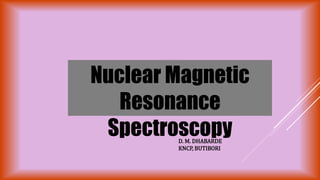
nmrspectroscopy-.pptx
- 1. Nuclear Magnetic Resonance Spectroscopy D. M. DHABARDE KNCP, BUTIBORI
- 2. 2 Nuclear magnetic resonance is the study of molecules by measuring the interaction of radiofrequency electromagnetic radiations in the region 4 to 900 MHz with the nuclei of molecules placed in a strong magnetic field. It is used to characterize organic molecules by identifying carbon-hydrogen frameworks within the molecules and also used in quality control and research for determining the content and purity of a sample as well as its molecular structure. The protons present in the molecule will behave differently depending on the surrounding chemical environment, making it possible to elucidate their structure.
- 3. Types of NMR- Two types of NMR spectroscopy are used 1. 1 H NMR- used to determine the type and number of H atoms in a molecule. 2. 13 C NMR- used to determine the type of carbon atoms in a molecule TheoryofNMR The rules for determining the net spin of a nucleus are as follows; If the number of neutrons and the number of protons are both even, then the nucleus has NO spin. If the number of neutrons plus the number of protons is odd, then the nucleus has a half-integer spin (i.e. 1/2, 3/2, 5/2)
- 4. Spinquantumnumber(I) isrelatedtotheatomicandmassnumberofthenucleus I Z A Eg; Half integer Odd Odd 1H (1/2) Half integer Odd Even 13C (1/2) Integer Even Odd 2H(1) Zero Even Even 12C (0) Elementswitheitheroddmassoroddatomicnumberhavethepropertyofnuclear“spin” 3
- 5. • If anexternalmagneticfieldis applied,thenumberofpossibleorientationscalculatedby(2I+1). Eg.:-HydrogenhasspinquantumnumberI=1/2andpossibleorientationis (2*1/2+1=2)two,ie,+1/2and-1/2. 4
- 6. PRINCIPLE OF NMR •The principleis basedonthe- spinning of nucleus and generating amagnetic field. •Withoutexternal magnetic(Bo) – field nuclear spinarerandom in direction. •With Bo ,nuclei align themselves eitherwith oragainst field of external magnetic field 5
- 7. • If anexternalmagneticfieldis applied,anenergytransfer(ΔE) is possiblebetweengroundstatetoexcited state. • Whenthespinreturnstoitsgroundstatelevel,theabsorbedradiofrequencyenergyisemittedatthesamefrequency level. • TheemittedradiofrequencysignalthatgivetheNMRspectrumoftheconcernednucleus.andis directlyproportionaltothestrengthoftheappliedfield 7
- 8. NMR SPECTRUM NMRspectrumis aplotofintensityofNMRsignalsvs magneticfield(frequency)inreference toTMS ReasonsfortakingTMS asreferenceStandard 1. Chemicallyinert,magneticallyisotopic,volatile&solubleinmostorganicsolvents. 2. TMSgivesanintensesignal. 3. TMScanbeeasilyremoved. 4. Electronegativity is low. 5. Itdoesn’tmakeanyintermolecularassociationwithsample 8
- 9. CHEMICAL SHIFT • Is theresonancefrequencyofanucleusrelativetoastandardinamagneticfield. • TMSis themostcommonreferencecompoundinNMR,itis setat𝛿 = 0𝑝𝑝𝑚 𝛿=ν𝑠𝑎𝑚𝑝𝑙𝑒 − 𝜈𝑟𝑒𝑓 𝜈𝑟𝑒𝑓 Shieldingofprotons:-Highelectrondensityaroundanucleusshieldsthenucleusfrom theexternalmagneticfieldandthesignalsareupfieldintheNMRspectrum Deshieldingofprotons:-Lowerelectrondensityaroundanucleusdeshieldsthenucleus fromtheexternalmagneticfieldandthesignalsaredownfieldintheNMRspectrum 9
- 10. FACTORSAFFECTING CHEMICAL SHIFT • Electronegativegroups/Inductiveeffect • Magneticanisotropyofπ-systems/diamagneticeffectofpibond • Hydrogenbonding • VanderWaal'sdeshielding • Effectoftemperature&Effectofsolvent Electronegativegroups:-ElectronegativegroupsattachedtotheC-H systemdecreasethe electrondensityaroundtheprotons,andthereislessshielding(i.e.deshielding)andchemical shiftincreases Compound Chemical shift CH3I 2.16 CH3Br 2.65 CH3Cl 3.10 CH3F 4.26 10
- 11. MAGNETICANISOTROPY Somagneticanisotropymeansthatthereis a"non-uniformmagneticfield". Electronsin π systems(e.g.aromatics,alkenes,alkynes,carbonylsetc.)interactwiththeappliedfield whichinducesamagneticfieldthatcausestheanisotropy. Itcausesbothshieldingandde-shieldingofprotons. Example:-Benzene Vander Waal'sdeshielding Theelectroncloudofabulkiergroupwill tendtorepeltheelectroncloudsurroundingtheproton. suchaprotonwill bedeshielded&will resonateatslightlyhighervalueofδ thanexpectedinthe absenceofthiseffect. Effectof temperature Resonancepositionofmostsignalsis littleaffectedbytemperature. 11
- 12. CHEMICAL SHIFT CHANGEWHENTHESOLVENT CHANGEDFROMCCL4 TOCDCL3 IS0.1 PPM.BUTCHANGETO MOREPOLAR SOLVENTS LIKEMETHANOL,THECHANGEIS 0.3PPM. Effect of Solvent 12
- 13. SOLVENTS USEDIN NMR CCl4, CS2, CDCl3, C6D6, D2O Hydrogen bonding Protons thatareinvolvedin hydrogenbondingaretypically changethechemicalshift values. Themorehydrogenbonding,themoreproton is deshieldedandchemicalshift valueis higher.
- 14. PROTON NMR Themostcommon spectrum forNMRis basedonthehydrogen-1(1H),nucleusorproton.It cangive informationaboutthestructureofanymoleculecontaininghydrogenatoms. Eg,ethanol 3typesof;-CH2,CH3,OH Interpretationof1HNMR spectra:- Numberofsignals Positionofsignals Relativeintensityofsignals Splittingofsignals(spinspincoupling) - Indicateshowmany"differentkinds"ofprotonsarepresent. - Indicatessomethingabout(chemicalshift) magnetic (electronic)environmentofprotons - Proportionaltonumberofprotonspresentsignals - Indicatesthenumberofnearbynuclei usually protons13
- 15. N+1 RULE • Themultiplicity ofsignalis calculatedbyusingn+1rule. • This is oneoftheruletopredictthesplittingofprotonsignals.This is consideredbythe nearbyhydrogennuclei. Therefore,n=Numberofprotonsinnearbynuclei ZeroH atomasneighbourn+1=0+1=1(singlet) OneH atomasneighbourn+1=1+1= 2(doublet) TwoH atomasneighbourn+1=2+1=3(triplet) Spin-spincoupling(splitting) Theinteractionbetweenthespinsofneighbouringnucleiinamoleculemaycausethe splittingofNMR spectrum.Thesplittingpatternis relatedtothenumberofequivalentH- atomatthenearbynuclei. Eg.,Ethylacetate 14
- 16. SPIN-SPIN COUPLING (SPLITTING) CONSTANT 15
- 17. RULES FOR SPIN-SPIN COUPLING • Chemicallyequivalentprotonsdonotshowspin-spincoupling &Onlynonequivalent protonscouple. X X Hb Hc Hd H Ha C C C C H HbcoupleswithHc Hb&Hadonotcouplebecausetheyareequivalent Hc &Hd donotcouplebecausetheyareequivalent H H H H • Protonsonadjacentcarbonsnormallywill couple. • Protonsseparatedbyfourormorebondswill notcouple. 16
- 18. ORIGINS OF SIGNAL SPLITTING Theoriginsofsignalsplittingpatternsin which,eacharrowrepresentsanHbnuclear spinorientation. COUPLING CONSTANT (J-Hz) • Measurementofsplittingeffectis basedon thedistancebetweenthepeakinagiven multiplet. • Usefulin1HNMRofcomplexstructure 17
- 19. INSTRUMENTATI ON 1. Sampletube/sampleholder 2. Permanentmagnet 3. Magnetcoil 4. Sweepgenerator 5. Radiofrequency transmitter 6. Radiofrequency reviever 7. Readoutsystem 18
- 20. • Sampletube/sampleholder Itshouldbechemicallyinert, durable&transparenttoNMRradiation. Generallyabout8.5cmlong&approximately0.3cmindiameterisemployed. • Sampleprobe It’sthedevicethatholdsampletubeinposition&is providedwithanairdriventurbine forrotatingthesampletubealmost100revolutionspermin. • PermanentMagnet Itprovidehomogenousmagneticfieldat60-100MHz • Magneticcoil Itinducemagneticfieldwhencurrentflowthroughthem • Sweepgenerator Toproduceequalamountofmagneticfieldpassthroughthesample 19
- 21. • Radiofrequencytransmitter transmitterisfedontoapairofcoilsmountedonrightangles tothepathoffield. 60MHzcapacity isnormallyused. • Radiofrequencyreceiver detectradiofrequenciesemittedas nuclei relaxatlowerenergylevel • Signal detector& recording system Theelectricalsignalgeneratedis amplifiedbymeans ofamplifier&thenrecorded. 20
- 22. APPLICATION ……… • 1HNMRusedforstructuralelucidationoforganicandinorganicsolids • determinesthephysicalandchemicalpropertiesofatoms • Applicationinmedicine • Anatomical imaging • Measuringphysiological function • Flowmeasurementandangiography • Tissueperfusionstudies • Tumours • MRI 21
- 23. • Distinguishinggreymatter&whitematter • Imagingposteriorfossae, brainstem,spinalcord • Detectdemyelinatinglesions,tumour ,haemorrhage,infarctions ABDOMEN • Metabolicliverdisease • Focalareasofinflammationinchronicactivehepatisis KIDNEY • Distinguishingrenalcorta&medulla • Toevaluatetransplantedkidney PELVIS • Differentiatebetweenbenignprostatichyperplasia&prostaticcarcinoma 22
- 24. REFERENCES • Organicspectroscopy,WillaimKemp • Instrumental methodofchemical analysis • Instrumental methodofchemical analysis. Wilard • https://www.slideshare.net/solairajananant/nmr-spectroscopy-13887430 • http://sydney.edu.au/science/chemistry/facilities/nmr/nmr-applications.shtml 23